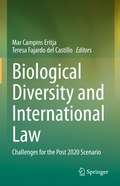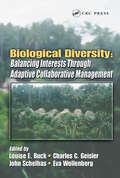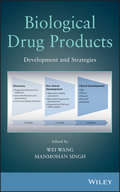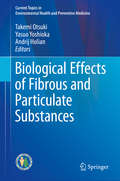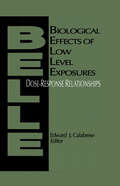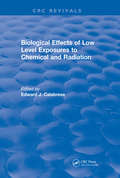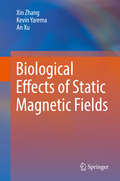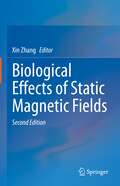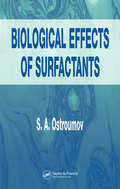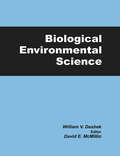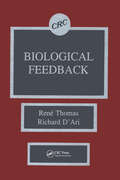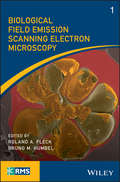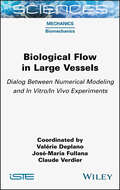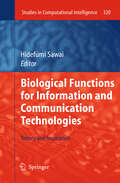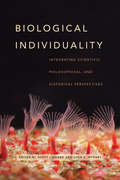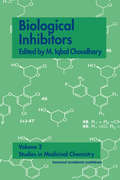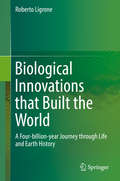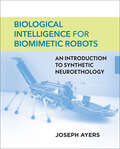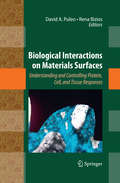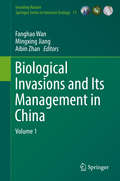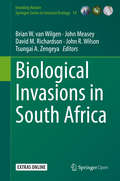- Table View
- List View
Biological Diversity and International Law: Challenges for the Post 2020 Scenario
by Mar Campins Eritja Teresa Fajardo del CastilloThe book focuses on the interactions between international legal regimes related to biodiversity governance. It addresses the systemic challenges by analyzing the legal interactions between international biodiversity law and related international law applicable to economic activities, as well as issues related to the governance of biodiversity based on functional, normative, and geographic dimensions, in order to present a crosscutting, holistic approach. The global COVID-19 pandemic, the imminent revision of the Strategic Plan for Biodiversity 2011-2020, and the Aichi Targets have created the momentum to focus on the interactions between the Convention on Biological Diversity and other international environmental regimes. Firstly, it discusses the principles that inspire biodiversity-related conventional law, the soft law that conveys targets for enforcement of the Biodiversity Convention, their structural, regulatory and implementation gaps, the systemic relations arising from national interests, and the role of scientific advisory bodies in biodiversity-related agreements. The second part then addresses interactions in specific conventional frameworks, such as the law of multilateral trade and global public health, and the participation of communities in the management of genetic resources. Lastly, the third part illustrates these issues using four case studies focusing on the challenges for sustainability and marine biodiversity in small islands, the Arctic Ocean, the Caribbean Sea, and the Mediterranean Sea, as a way to strengthen a horizontal and joint approach. The book is primarily intended for academics, researchers, and students interested in international environmental law and policy and in interactions for creating conditions for fair, sustainable, and resilient environmental development. By offering an analysis of instruments and criteria for systemic relations in those areas, it will also appeal to public and private actors at the domestic and international level.
Biological Diversity: Balancing Interests Through Adaptive Collaborative Management
by John Schelhas Eva Wollenberg Louise E. Buck Charles C. GeislerWe live in a world of wide pendulum swings regarding management policies for protected areas, particularly as they affect the involvement of local people in management. Such swings can be polarizing and halt on-the-ground progress. There is a need to find ways to protect biodiversity while creating common ground and building management capacity thr
Biological Drug Products: Development and Strategies
by Manmohan Singh Wei WangTested and proven solutions to the challenges of biological drug product development Biological drug products play a central role in combating human diseases; however, developing new successful biological drugs presents many challenges, including labor intensive production processes, tighter regulatory controls, and increased market competition. This book reviews the current state of the science, offering readers a single resource that sets forth the fundamentals as well as tested and proven development strategies for biological drugs. Moreover, the book prepares readers for the challenges that typically arise during drug development, offering straightforward solutions to improve their ability to pass through all the regulatory hurdles and deliver new drug products to the market. Biological Drug Products begins with general considerations for the development of any biological drug product and then explores the strategies and challenges involved in the development of specific types of biologics. Divided into five parts, the book examines: Part 1: General Aspects Part 2: Proteins and Peptides Part 3: Vaccines Part 4: Novel Biologics Part 5: Product Administration/Delivery Each chapter has been prepared by one or more leading experts in biological drug development. Contributions are based on a comprehensive review and analysis of the current literature as well as the authors' first-hand experience developing and testing new drugs. References at the end of each chapter serve as a gateway to original research papers and reviews in the field. By incorporating lessons learned and future directions for research, Biological Drug Products enables pharmaceutical scientists and students to improve their success rate in developing new biologics to treat a broad range of human diseases.
Biological Effects of Fibrous and Particulate Substances (Current Topics in Environmental Health and Preventive Medicine #0)
by Takemi Otsuki Yasuo Yoshioka Andrij HolianThis volume examines our current understanding of the biological effects of fibrous and particulate substances, including discussions on nanoparticles. It offers comprehensive information on the latest insights into the immunological effects of various irritants on the human body. Readers will benefit from the contributing authors' diverse perspectives and extensive discussions of key issues, which include molecular alterations of the immune system and autoimmune diseases in connection with asbestos and silica, among others. The chapters also discuss recommendations, practical methods, and nanosafety science in situations involving exposure to nanotoxic substances. Edited in collaboration with the Japanese Society for Hygiene, this book provides up-to-date information on the immunological effects of nanotoxic substances to researchers interested in environmental and occupational health. Presenting a number of recent concepts and findings in the field, it enables readers to gain a comprehensive knowledge of health problems caused by environmental fibrous and particulate substances.
Biological Effects of Low Level Exposures Dose-Response Relationships
by Edward J. CalabreseBiological Effects of Low-Level Exposures, more commonly referred to as BELLE, began as a conference in May 1990. Its members are committed to the enhanced understanding of low-dose responses of all types to human exposures to chemical and physical agents, whether of an expected or paradoxical nature.The focus of BELLE encompasses dose-response relationships to toxic agents, pharmaceuticals, and natural products over wide dosage ranges in both in vitro systems and in vivo systems, including human populations. While BELLE promotes the scientific understanding of low-level effects, its primary goal is the scientific evaluation of existing literature and ways to improve research and assessment methods.
Biological Effects of Low Level Exposures to Chemical and Radiation (CRC Press Revivals)
by Edward J. CalabreseThis book features papers presented at a workshop discussing current knowledge about the biological effects of low level exposures (BELLE). The book is designed to help establish a scientific base for future BELLE initiatives and is focused on the issue of the toxicological implications of biological adaptations. Hormesis is considered in a broad, conceptual manner, as well as at molecular and biochemical levels. Other topics covered include the effects of low levels of radiation on biological systems, how the liver adapts to genetic insults, biostatistical considerations when designing studies that address issues associated with biological responses to low doses of chemicals and radiation, and the issues that surround the interpretation of findings from such studies.
Biological Effects of Static Magnetic Fields
by Xin Zhang Kevin Yarema An XuThe book summarize the emerging topic about the effects of SMF on biological samples ranging from single molecules, subcellular compartments, and cells to whole organisms, as well as the potential application of SMF in clinical treatment of cancer and other diseases. With the development and growing popularity of modern appliances, including MRI in the hospitals, the potential impact of magnetic fields on human health is invoking increasing concerns. At the same time, static magnetic field (SMF) has been used in the clinical treatment of tumors and other diseases for decades. However, there are still some reservations and uncertainties about these treatments, which are largely due to the differential biological effects reported in the literature. These experimental inconsistencies are mainly caused by variations such as different magnetic field types, intensities, treatment time as well as biological samples examined. This volume will help clarify some dilemmas in this field and encourage further investigation in order to achieve a better understanding of the biological effects of SMF, aiming for a rational application of SMF in clinical therapy in the near future. The book is useful for scientists and students in static magnetic field and clinical doctors et cl.
Biological Effects of Static Magnetic Fields
by Xin ZhangThe book summarizes the emerging topic about the effects of SMF on biological samples ranging from single molecules, subcellular compartments, and cells to whole organisms. It also discusses the potential application of SMF in clinical treatment of cancer, pain, diabetes and other diseases.With the development and growing popularity of modern appliances like MRI in hospitals, the potential impact of magnetic fields on human health is invoking increasing concerns. At the same time, SMF has been explored in the treatment of tumor and other diseases for decades. Nevertheless, there are still some reservations and uncertainties about these treatments, which are largely due to the differential biological effects reported in the literature. These experimental inconsistencies are mainly caused by variations such as different magnetic field types, intensities, treatment time, as well as biological samples examined. The second edition added eight new chapters about new progress in this field including impacts of SMFs, magnetism of biomolecules, and potential of SMFs in the management of bone, pain, diabetes, and immune systems. This volume will help clarify some dilemmas in this field and encourage further investigations in order to achieve a better understanding of the biological effects of SMF, aiming for a rational application of SMF in clinical therapy in the near future. The book is useful for scientists, doctors, and students who are interested in magnetic fields and life sciences
Biological Effects of Surfactants
by S.A. OstroumovOffering a new perspective on the hazards of pollution, Biological Effects of Surfactants examines the effects of anionic, non-ionic, cationic surfactants, and detergents on a wide range of organisms, populations, communities, and ecosystems. The author establishes new quantitative characteristics of the effects and presents study results on newly discovered phenomena. While proposing and substantiating new priorities and approaches for testing, assessing, and characterizing the biological activities and hazards of substances, the book illustrates how the data obtained can be used to develop effective environmental remediation and protection measures to improve water quality.
Biological Environmental Science
by William V DashekBiological Environmental Science is an introductory textbook for undergraduate students who desire a one semester course or, alternatively, a springboard course for advanced environmental offerings. This book features timely issues such as global warming, air, ground and water pollutions, population growth, species extinction and environmental policy. Unique features of this book include the use of research data and literature, copious illustrations and appendices for the scientific method.
Biological Evidence
by Ann Bucholtz Jon Lewis"The text is an introduction to the types of biological evidence commonly found at crime scenes and how to collect it for non-science majors and for professionals working in the criminal justice system. Specific biological evidence discussed includes blood, semen, saliva, urine, feces, hair, and fingernails. Additional topics include autopsy, the basic departments of the crime laboratory, toxicology, forensic entomology, and uncollectible biological evidence. Packaging, preservation, and care of biological evidence is discussed and chain of custody is explained. Additional topics include DNA, case studies, courtroom testimony, and exhibits for the courtroom.
Biological Evolution: An Introduction
by Mike CassidyBiological evolution, the theory of natural selection and of common descent, is a triumph both of human reasoning and scientific undertaking. The biological discipline of evolution contains both a chronicle of human endeavour and the story of life on Earth. This book is concerned with living forms and how they developed from 'simple and unpromising beginnings'. It considers evolution as both process and product. The author, an experienced teacher and educator, employs a historical narrative, used to convey the idea of 'change with modification' and to emphasise the relevance of evolution to contemporary bioscience. Biological evolution has now become part of the scientific orthodoxy and this accessible text will assist undergraduate students in the biological sciences within any ongoing debate.
Biological Feedback
by Rene Thomas Richard D'AriClearly explaining the logical analysis of biological control phenomena, Biological Feedback answers questions concerning everything from regulation to logic. This rare monograph presents a formal methodology for analyzing the dynamic behavior of complex systems. The easy-to-read text describes a simple logical formalization called "kinetic logic". The reader discovers how this method is used to predict all possible patterns of behavior of which a system is capable. It includes specific conditions required for each pattern. It also explains how to modify an incorrect model in order to account for the observed behavior. The authors give special attention to the two basic types of simple feedback loops: positive and negative. This volume is filled with easy-to-use tables, providing quick reference throughout the book. The subject matter is of great interest to everyone working in molecular genetics and developmental biology. Researchers, immunologists, physical chemists, physicists, electrical engineers, economists, and mathematicians will find this unique text to be an informative, indispensable resource.
Biological Field Emission Scanning Electron Microscopy (RMS - Royal Microscopical Society)
by Roland A. Fleck Bruno M. HumbelThe go‐to resource for microscopists on biological applications of field emission gun scanning electron microscopy (FEGSEM) The evolution of scanning electron microscopy technologies and capability over the past few years has revolutionized the biological imaging capabilities of the microscope—giving it the capability to examine surface structures of cellular membranes to reveal the organization of individual proteins across a membrane bilayer and the arrangement of cell cytoskeleton at a nm scale. Most notable are their improvements for field emission scanning electron microscopy (FEGSEM), which when combined with cryo-preparation techniques, has provided insight into a wide range of biological questions including the functionality of bacteria and viruses. This full-colour, must-have book for microscopists traces the development of the biological field emission scanning electron microscopy (FEGSEM) and highlights its current value in biological research as well as its future worth. Biological Field Emission Scanning Electron Microscopy highlights the present capability of the technique and informs the wider biological science community of its application in basic biological research. Starting with the theory and history of FEGSEM, the book offers chapters covering: operation (strengths and weakness, sample selection, handling, limitations, and preparation); Commercial developments and principals from the major FEGSEM manufacturers (Thermo Scientific, JEOL, HITACHI, ZEISS, Tescan); technical developments essential to bioFEGSEM; cryobio FEGSEM; cryo-FIB; FEGSEM digital-tomography; array tomography; public health research; mammalian cells and tissues; digital challenges (image collection, storage, and automated data analysis); and more. Examines the creation of the biological field emission gun scanning electron microscopy (FEGSEM) and discusses its benefits to the biological research community and future value Provides insight into the design and development philosophy behind current instrument manufacturers Covers sample handling, applications, and key supporting techniques Focuses on the biological applications of field emission gun scanning electron microscopy (FEGSEM), covering both plant and animal research Presented in full colour An important part of the Wiley-Royal Microscopical Series, Biological Field Emission Scanning Electron Microscopy is an ideal general resource for experienced academic and industrial users of electron microscopy—specifically, those with a need to understand the application, limitations, and strengths of FEGSEM.
Biological Flow in Large Vessels: Dialog Between Numerical Modeling and In Vitro/In Vivo Experiments
by Valerie Deplano Jose-Maria Fullana Claude VerdierThis book examines recent methods used for blood flow modeling and associated in vivo experiments, conducted using experimental data from medical imaging. Different strategies are proposed, from smallscale models to complex 3D modeling using modern computational codes. The geometries are wide-ranging and deal with the narrowing and widening of sections (stenoses, aneurysms), bifurcations, geometries associated with prosthetic elements, and even cases of vessels with smaller dimensions than those of the blood cells circulating in them.Biological Flow in Large Vessels provides answers to the question of how medical and biomechanical knowledge can be combined to address clinical problems. It offers guidance for further development of numerical models, as well as experimental protocols applied to clinical research, with tools that can be used in real-time and at the patient’s bedside, for decision-making support, predicting the progression of pathologies, and planning personalized interventions.
Biological Functions for Information and Communication Technologies: Theory and Inspiration (Studies in Computational Intelligence #320)
by Hidefumi SawaiBy incorporating biologically-inspired functions into ICT, various types of new-generation information and communication systems can be created. Just some example of areas already benefiting from such design inspiration are network architectures, information processing, molecular communication, and complex network modeling for solving real world-problems. This book provides the theoretical basis for understanding these developments and explains their practical applications. Highlighted inserts appears throughout to help readers to understand the very latest topics in these emerging research fields. The book ends with a more philosophical discussion on how new ICT solutions can be found by looking at analogous systems in biology. This new way of thinking may help researchers and practitioners to apply innovative ideas in developing next-generation technologies.
Biological Individuality: Integrating Scientific, Philosophical, and Historical Perspectives
by Lynn K. Nyhart Scott Lidgard and Lynn K. NyhartIndividuals are things that everybody knows—or thinks they do. Yet even scholars who practice or analyze the biological sciences often cannot agree on what an individual is and why. One reason for this disagreement is that the many important biological individuality concepts serve very different purposes—defining, classifying, or explaining living structure, function, interaction, persistence, or evolution. Indeed, as the contributors to Biological Individuality reveal, nature is too messy for simple definitions of this concept, organisms too quirky in the diverse ways they reproduce, function, and interact, and human ideas about individuality too fraught with philosophical and historical meaning. Bringing together biologists, historians, and philosophers, this book provides a multifaceted exploration of biological individuality that identifies leading and less familiar perceptions of individuality both past and present, what they are good for, and in what contexts. Biological practice and theory recognize individuals at myriad levels of organization, from genes to organisms to symbiotic systems. We depend on these notions of individuality to address theoretical questions about multilevel natural selection and Darwinian fitness; to illuminate empirical questions about development, function, and ecology; to ground philosophical questions about the nature of organisms and causation; and to probe historical and cultural circumstances that resonate with parallel questions about the nature of society. Charting an interdisciplinary research agenda that broadens the frameworks in which biological individuality is discussed, this book makes clear that in the realm of the individual, there is not and should not be a direct path from biological paradigms based on model organisms through to philosophical generalization and historical reification.
Biological Inhibitors
by M. Iqbal ChoudharyThis book, a part of the series Studies in Medicinal Chemistry, details the biological inhibitors that reflect drug discovery in treating human diseases, including cardiovascular, nervous, inflammatory, hormonal and metabolic processes. Compounds for fungal diseases and HIV/AIDS are also covered.
Biological Innovations that Built the World: A Four-billion-year Journey through Life and Earth History
by Roberto LigroneThe book is a detailed account of major biological events that contributed to create the present world and our species, with emphasis on cause-effect interrelationships and environmental impact. Its main goal is to guide the reader toward an understanding of the continuity of life across diversity, and of its large-scale interactions with the planet. Combining scientific soundness with a constant effort for clarity, the book begins with a cloud of dust in a corner of the Galaxy and, covering an immense lapse of time, terminates with an organism that ponders about the texture of the Universe. Comprehensive, updated references added to each chapter will help the reader wishing to expand any of the topics. A glossary explains less common technical terms.
Biological Intelligence for Biomimetic Robots: An Introduction to Synthetic Neuroethology
by Joseph AyersAn introduction to how neuroethology can inform the development of robots controlled by synaptic networks instead of algorithms, from a pioneer in biorobotics.The trait most fundamental to the evolution of animals is the capability to adapt to novel circumstances in unpredictable environments. Recent advances in biomimetics have made it feasible to construct robots modeled on such unsupervised autonomous behavior, and animal models provide a library of existence proofs. Filling an important gap in the field, this introductory textbook illuminates how neurobiological principles can inform the development of robots that are controlled by synaptic networks, as opposed to algorithms. Joseph Ayers provides a comprehensive overview of the sensory and motor systems of a variety of model biological systems and shows how their behaviors may be implemented in artificial systems, such as biomimetic robots. Introduces the concept of biological intelligence as applied to robots, building a strategy for autonomy based on the neuroethology of simple animal modelsProvides a mechanistic physiological framework for the control of innate behaviorIllustrates how biomimetic vehicles can be operated in the field persistently and adaptivelyDeveloped by a pioneer in biorobotics with decades of teaching experienceProven in the classroom Suitable for professionals and researchers as well as undergraduate and graduate students in cognitive science and computer science
Biological Interactions on Materials Surfaces: Understanding and Controlling Protein, Cell, and Tissue Responses
by Rena Bizios David A. PuleoSuccess or failure of biomaterials, whether tissue engineered constructs, joint and dental implants, vascular grafts, or heart valves, depends on molecular-level events that determine subsequent responses of cells and tissues. This book presents the latest developments and state-of-the-art knowledge regarding protein, cell, and tissue interactions with both conventional and nanophase materials. Insight into these biomaterial surface interactions will play a critical role in further developments in fields such as tissue engineering, regenerative medicine, and biocompatibility of implanted materials and devices. With chapters written by leaders in their respective fields, this compendium will be the authoritative source of information for scientists, engineers, and medical researchers seeking not only to understand but also to control tissue-biomaterial interactions.
Biological Invasions and Animal Behaviour
by Weis Judith S. Daniel SolHow does behaviour affect biological invasions? Can it explain why some animals are such successful invaders? With contributions from experts in the field, and covering a broad range of animals, this book examines the role of behaviour in biological invasions from the point of view of both invaders and native species. The chapters cover theoretical aspects, particularly relevant behaviours and well-documented case studies, showing that behaviour is critical to the success, and ecological and socio-economic impact, of invasive species. Its insights suggest methods to prevent and mitigate those impacts, and offer unique opportunities to understand the adaptive role of behaviour. Offering a comprehensive overview of current understanding on the subject, the book is intended for biological invasion researchers and behavioural ecologists as well as ecologists and evolutionary biologists interested in how organisms deal with anthropogenic environmental changes such as climate change and habitat loss.
Biological Invasions and Its Management in China: Volume 1 (Invading Nature - Springer Series in Invasion Ecology #11)
by Fanghao Wan Mingxing Jiang Aibin ZhanThe book discusses invasive-species problems in agriculture, forests and aquatic ecosystems, highlighting the invasive mechanisms and management of the selected invasive species. Biological invasion has become a serious global ecological and economic problem that deserves particular attention from both government officials and scientists. This volume focuses on three key scientific areas: 1) population establishment and spreading mechanisms of the selected invasive species; 2) ecology adaptation, population growth, expansion and evolution of invasive species; and 3) impact of bio-invasion on the ecosystem structure and function at community and ecosystem levels. The presented research will result in techniques for better management of invasive species. Dr. Fanghao Wan is a professor at the Chinese Academy of Agricultural Sciences Institute of Plant Protection in Beijing, China. Dr. Mingxing Jiang is a professor at Zhejiang University's College of Agriculture and Biotechnology Institute of Insect Sciences in Hangzhou, China. Dr. Aibin Zhan is a researcher at the Center for Eco-Environmental Sciences (RCEES) at the Chinese Academy of Sciences (CAS), Beijing, China.
Biological Invasions and Its Management in China: Volume 2 (Invading Nature - Springer Series in Invasion Ecology #13)
by Fanghao Wan Mingxing Jiang Aibin ZhanThe book discusses invasive-species problems in agriculture, forests and aquatic ecosystems, highlighting the invasive mechanisms and management of the selected invasive species. Biological invasion has become a serious global ecological and economic problem that deserves particular attention from both government officials and scientists. This volume focuses on three key scientific areas: 1) population establishment and spreading mechanisms of the selected invasive species; 2) ecology adaptation, population growth, expansion and evolution of invasive species; and 3) impact of bio-invasion on the ecosystem structure and function at community and ecosystem levels. The presented research will result in techniques for better management of invasive species. Dr. Fanghao Wan is a professor at the Chinese Academy of Agricultural Sciences Institute of Plant Protection in Beijing, China. Dr. Mingxing Jiang is a professor at Zhejiang University's College of Agriculture and Biotechnology Institute of Insect Sciences in Hangzhou, China. Dr. Aibin Zhan is a researcher at the Center for Eco-Environmental Sciences (RCEES) at the Chinese Academy of Sciences (CAS), Beijing, China.
Biological Invasions in South Africa (Invading Nature - Springer Series in Invasion Ecology #14)
by David M. Richardson John R. Wilson Brian W. van Wilgen John Measey Tsungai A. ZengeyaThis open access volume presents a comprehensive account of all aspects of biological invasions in South Africa, where research has been conducted over more than three decades, and where bold initiatives have been implemented in attempts to control invasions and to reduce their ecological, economic and social effects. It covers a broad range of themes, including history, policy development and implementation, the status of invasions of animals and plants in terrestrial, marine and freshwater environments, the development of a robust ecological theory around biological invasions, the effectiveness of management interventions, and scenarios for the future. The South African situation stands out because of the remarkable diversity of the country, and the wide range of problems encountered in its varied ecosystems, which has resulted in a disproportionate investment into both research and management. The South African experience holds many lessons for other parts of the world, and this book should be of immense value to researchers, students, managers, and policy-makers who deal with biological invasions and ecosystem management and conservation in most other regions.
